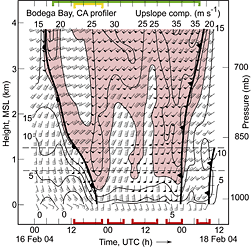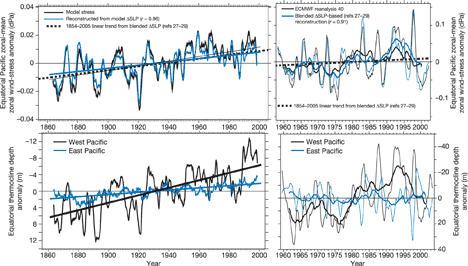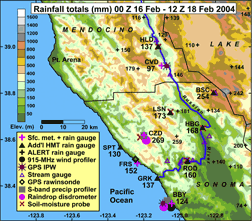NOAA Research Home » Outstanding Papers
NOAA Research 2007 Outstanding Scientific Paper Awards
“Flooding on California’s Russian River: Role of atmospheric rivers”

Time-height section of hourly averaged wind profiles, upslope-component isotachs (m s-1, directed from 230°; >20 m s-1 red-shaded), and fronts at BBY on 16– 18 February 2004 (wind flags = 25 m s-1, barbs = 5 m s-1, half-barbs = 2.5 m s-1). Colored brackets denote the following observations at BBY: red = LLJ episodes; green = IWV > 2 cm; yellow = IWV > 3 cm. Data within the pair of dashed lines (750–1250 m MSL) were layer-averaged and presented in Figure 3. (larger image)

Composite SSM/I satellite image of IWV (cm; color bar at bottom) constructed from polar-orbiting swaths between ∼1400 and 1830 UTC 16 February 2004, and ranking of daily streamflows (percent; see inset key) on 17 February 2004 for those gauges that have recorded data for ≥30 years. The streamflow data are based on local time (add 8 h to convert to UTC. (larger image)

Terrain base map of northern California’s Russian River watershed showing the locations of the observing systems (see key). The three-letter station names are given for the experimental sites. The numerical values represent the 60-h accumulated rainfall between 0000 UTC 16 February and 1200 UTC 18 February 2004. (larger image)
NOAA Research Home » Outstanding Papers
CLIMATE · OCEANS,
GREAT LAKES, and COASTS · WEATHER
and AIR QUALITY
ABOUT US · RESEARCH
PROGRAMS · EDUCATION · HOME
10/22/07
